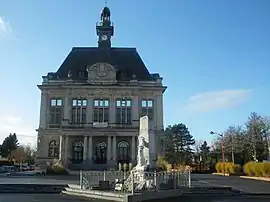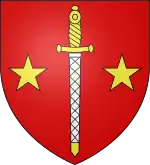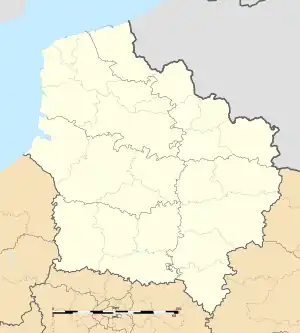Calonne-Ricouart | |
|---|---|
 The town hall of Calonne-Ricouart | |
 Coat of arms | |
Location of Calonne-Ricouart | |
 Calonne-Ricouart  Calonne-Ricouart | |
| Coordinates: 50°29′15″N 2°29′04″E / 50.4875°N 2.4844°E | |
| Country | France |
| Region | Hauts-de-France |
| Department | Pas-de-Calais |
| Arrondissement | Béthune |
| Canton | Auchel |
| Intercommunality | CA Béthune-Bruay, Artois-Lys Romane |
| Government | |
| • Mayor (2020–2026) | Ludovic Idziak[1] |
| Area 1 | 4.61 km2 (1.78 sq mi) |
| Population | 5,463 |
| • Density | 1,200/km2 (3,100/sq mi) |
| Time zone | UTC+01:00 (CET) |
| • Summer (DST) | UTC+02:00 (CEST) |
| INSEE/Postal code | 62194 /62470 |
| Elevation | 41–114 m (135–374 ft) (avg. 65 m or 213 ft) |
| 1 French Land Register data, which excludes lakes, ponds, glaciers > 1 km2 (0.386 sq mi or 247 acres) and river estuaries. | |
Calonne-Ricouart (French pronunciation: [kalɔn ʁikwaʁ]) is a commune in the Pas-de-Calais department in the Hauts-de-France region of France.[3]
Geography
Calonne-Ricouart is an ex-coalmining town some 6 miles (9.7 km) southwest of Béthune and 33 miles (53 km) southwest of Lille, at the junction of the D70 and the D341 roads, by the banks of the river Clarence.
History
The village and the old castle were burned down in 1537 by the troops of Francis I.
The church of St. Pierre was rebuilt between the years 1763 to 1781.
In 1786, a new chateau was built at the present location of the cemetery.
Around the same time, through the initiative of Bernard Calonne, the watermill was built on the north bank of the river Clarence. It was sold during the Revolution and ceased functioning as a working mill in 1945. Nowadays, only a small part of the original building still exists.
Features
The spoil heaps from the years of mining coal are now disappearing, as they contain material which can be used in road building. To the east of the town, were once the pit heads stood, is Park Calonnix, which covers 35 hectares of land including 15 hectares of forest and 5 hectares of ponds. Various sports and leisure activities are available (tennis, squash, horseriding, a climbing wall, pedal boats, freshwater and trout fishing, an inflatable playground and an animal park. Also located on the site, in the former coal mining explosives store, is a bat sanctuary.
Population
| Year | Pop. | ±% p.a. |
|---|---|---|
| 1968 | 9,954 | — |
| 1975 | 8,534 | −2.17% |
| 1982 | 7,545 | −1.74% |
| 1990 | 6,585 | −1.69% |
| 1999 | 5,989 | −1.05% |
| 2007 | 5,815 | −0.37% |
| 2012 | 5,528 | −1.01% |
| 2017 | 5,454 | −0.27% |
| Source: INSEE[4] | ||
Places of interest
- The church of St. Pierre, dating from the eighteenth century.
- The modern church of St.Paul.
- An old farm and a watermill.
Notable people
- Robert Budzynski (born 1940), football player
- Maryan Synakowski (1936–2022), football player
- Maryan Wisniewski (born 1937), football player
See also
References
- ↑ "Répertoire national des élus: les maires" (in French). data.gouv.fr, Plateforme ouverte des données publiques françaises. 13 September 2022.
- ↑ "Populations légales 2021". The National Institute of Statistics and Economic Studies. 28 December 2023.
- ↑ INSEE commune file
- ↑ Population en historique depuis 1968, INSEE
External links
- Official website of the commune (in French)
- The leisure park (in French)